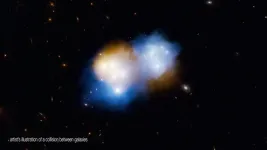Astronomers have untangled a messy collision between two massive clusters of galaxies in which the clusters' vast clouds of dark matter have decoupled from the so-called normal matter. The two clusters each contain thousands of galaxies and are located billions of light-years away from Earth. As they plowed through each other, the dark matter—an invisible substance that feels the force of gravity but emits no light—sped ahead of the normal matter. The new observations are the first to directly probe the decoupling of the dark and normal matter velocities.
Galaxy clusters are among the largest structures in the universe, glued together by the force of gravity. Only 15 percent of the mass in such clusters is normal matter, the same matter that makes up planets, people, and everything you see around you. Of this normal matter, the vast majority is hot gas, while the rest is stars and planets. The remaining 85 percent of the cluster mass is dark matter.
During the tussle that took place between the clusters, known collectivity as MACS J0018.5+1626, the individual galaxies themselves largely went unscathed because so much space exists between them. But when the enormous stores of gas between the galaxies (the normal matter) collided, the gas became turbulent and superheated. While all matter, including both normal matter and dark matter, interacts via gravity, the normal matter also interacts via electromagnetism, which slows it down during a collision. So, while the normal matter became bogged down, the pools of dark matter within each cluster sailed on through.
Think of a massive collision between multiple dump trucks carrying sand, suggests Emily Silich, lead author of a new study describing the findings in The Astrophysical Journal. "The dark matter is like the sand and flies ahead." Silich is a graduate student working with Jack Sayers, research professor of physics at Caltech and principal investigator of the study.
The discovery was made using data from the Caltech Submillimeter Observatory (which was recently removed from its site on Maunakea in Hawai‘i and will be relocated to Chile), the W.M. Keck Observatory on Maunakea, NASA's Chandra X-ray Observatory, NASA's Hubble Space Telescope, the European Space Agency's now-retired Herschel Space Observatory and Planck observatory (whose affiliated NASA science centers were based at Caltech's IPAC), and the Atacama Submillimeter Telescope Experiment in Chile. Some of the observations were made decades ago, while the full analysis using all the datasets took place over the past couple of years.
Such decoupling of dark and normal matter has been seen before, most famously in the Bullet Cluster. In that collision, the hot gas can be seen clearly lagging behind the dark matter after the two galaxy clusters shot through each other. The situation that took place in MACS J0018.5+1626 (referred to subsequently as MACS J0018.5) is similar, but the orientation of the merger is rotated, roughly 90 degrees relative to that of the Bullet Cluster. In other words, one of the massive clusters in MACS J0018.5 is flying nearly straight toward Earth while the other one is rushing away. That orientation gave researchers a unique vantagepoint from which to, for the first time, map out the velocity of both the dark matter and normal matter and elucidate how they decouple from each other during a galaxy cluster collision.
"With the Bullet Cluster, it's like we are sitting in a grandstand watching a car race and are able to capture beautiful snapshots of the cars moving from left to right on the straightaway," says Sayers. "In our case, it's more like we are on the straightaway with a radar gun, standing in front of a car as it comes at us and are able to obtain its speed."
To measure the speed of the normal matter, or gas, in the cluster, researchers used an observational method known as the kinetic Sunyaev-Zel'dovich (SZ) effect. Sayers and his colleagues made the first observational detection of the kinetic SZ effect on an individual cosmic object, a galaxy cluster named MACS J0717, back in 2013, using data from CSO (the first SZ effect observations taken of MACS J0018.5 date back to 2006).
The kinetic SZ effect occurs when photons from the early universe, the cosmic microwave background (CMB), scatter off electrons in hot gas on their way toward us on Earth. The photons undergo a shift, called a Doppler shift, due to the motions of the electrons in the gas clouds along our line of sight. By measuring the change in brightness of the CMB due to this shift, researchers can determine the speed of gas clouds within galaxy clusters.
"The Sunyaev-Zeldovich effects were still a very new observational tool when Jack and I first turned a new camera at the CSO on galaxy clusters in 2006, and we had no idea there would be discoveries like this," says Sunil Golwala, professor of physics and Silich's faculty PhD advisor. "We look forward to a slew of new surprises when we put next-generation instruments on the telescope at its new home in Chile."
By 2019, the researchers had made these kinetic SZ measurements in several galaxy clusters, which told them the speed of the gas, or normal matter. They had also used Keck to learn the speed of the galaxies in the cluster, which told them by proxy the speed of the dark matter (because the dark matter and galaxies behave similarly during the collision). But at this stage in the research, the team had a limited understanding of the orientations of the clusters. They only knew that one of them, MACS J0018.5, showed signs of something strange going on—the hot gas, or normal matter, was traveling in the opposite direction to the dark matter.
"We had this complete oddball with velocities in opposite directions, and at first we thought it could be a problem with our data. Even our colleagues who simulate galaxy clusters didn't know what was going on," Sayers says. "And then Emily got involved and untangled everything."
For part of her PhD thesis, Silich tackled the conundrum of MACS J0018.5. She turned to data from the Chandra X-ray Observatory to reveal the temperature and location of the gas in the clusters as well as the degree to which the gas was being shocked. "These cluster collisions are the most energetic phenomena since the Big Bang," Silich says. "Chandra measures the extreme temperatures of the gas and tells us about the age of the merger and how recently the clusters collided." The team also worked with Adi Zitrin of the Ben-Gurion University of the Negev in Israel to use Hubble data to map the dark matter using a method known as gravitational lensing.
Additionally, John ZuHone of the Center for Astrophysics at Harvard & Smithsonian helped the team simulate the cluster smashup. These simulations were used in combination with data from the various telescopes to ultimately determine the geometry and evolutionary stage of the cluster encounter. The scientists found that, prior to colliding, the clusters were moving toward each other at approximately 3000 kilometers/second, equal to roughly one percent of the speed of light. With a more complete picture of what was going on, the researchers were able to figure out why the dark matter and normal matter appeared to be traveling in opposite directions. Though the scientists say it's hard to visualize, the orientation of the collision, coupled with the fact that dark matter and normal matter had separated from each other, explains the oddball velocity measurements.
In the future, the researchers hope that more studies like this one will lead to new clues about the mysterious nature of dark matter. "This study is a starting point to more detailed studies into the nature of dark matter," Silich says. "We have a new type of direct probe that shows how dark matter behaves differently from normal matter."
Sayers, who recalls first collecting the CSO data on this object almost 20 years ago, says, "It took us a long time to put all the puzzle pieces together, but now we finally know what's going on. We hope this leads to a whole new way to study dark matter in clusters."
The study titled "ICM-SHOX. Paper I: Methodology overview and discovery of a gas–dark matter velocity decoupling in the MACS J0018.5+1626 merger," was funded by the National Science Foundation, the Wallace L. W. Sargent Graduate Fellowship at Caltech, the Chandra X-ray Center, the United States-Israel Binational Science Foundation, the Ministry of Science & Technology in Israel, the AtLAST (Atacama Large Aperture Submillimeter Telescope) project, and the Consejo Nacional de Humanidades Ciencias y Technologías.
END





